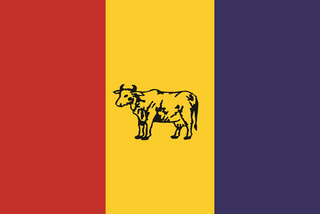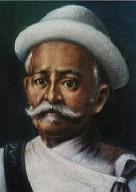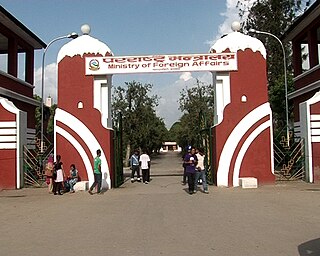
The Rastriya Prajatantra Party [Nepali pronunciation: [rasʈrijʌ prʌˈd͡zatʌntrʌ ˈpa(r)ʈi]) is a monarchist and Hindu nationalist political party in Nepal. It was formed by former prime ministers Surya Bahadur Thapa and Lokendra Bahadur Chand, who served two terms each since the end of the Rastriya Panchayat.

Bhimsen Thapa was the Mukhtiyar and de facto ruler of Nepal from 1806 to 1837.

Amar Singh Thapa Chhetri distinguished as Badakaji Amar Singh Thapa(Nepali: बडाकाजी अमर सिंह थापा क्षेत्री), or Amar Singh Thapa The Elder, also known by the honorific name Bada Kaji or Budha Kaji, was a Gorkhali military general, governor and warlord in the Kingdom of Nepal. He was the overall commander of the Nepal Army in the conquest of Western Provinces and authoritative ruler of Kumaon, Garhwal in the Kingdom of Nepal. He was referred by the King of Nepal to have been deployed as Mukhtiyar of Western Provinces of Kumaon, Garhwal He is often hailed as Living Tiger of Nepal and he was posthumously regarded as one of the national heroes of Nepal, who led the Anglo-Nepalese War for the Gorkhali Army. Amarsingh Chowk Pokhara and Shree Amarsingh Model Higher Secondary School are Named after the name of Amar Singh Thapa.

Bhakti Thapa Chhetri was a Nepalese military commander and administrator in the Kingdom of Nepal. Initially, he served for the Kingdom of Lamjung. He is considered one of the national heroes of Nepal.

Rana dynasty is a Chhetri dynasty that ruled the Kingdom of Nepal from 1846 until 1951, reducing the Shah monarch to a figurehead and making Prime Minister and other government positions held by the Ranas hereditary. They claimed Kshatriya status themselves. Rana dynasty is historically known for the iron-fisted rule. This changed after the Revolution of 1951 with the promulgation of a new constitution, when power shifted back to the monarchy of King Tribhuvan.

Thapa is the surname commonly used by Nepali people belonging to the Chhetri(Kshatriya) caste of the Khas group.

Kamal Thapa served as a Deputy Prime Minister and Federal Affairs and Local Development Minister of Nepal Government. He is also current president of Nepal's royalist party, the Rastriya Prajatantra Party. He served as a Home Minister during King Gyanendra's direct rule in 2006 until the king was forced to handover power to Girija Prasad Koirala of the Nepali Congress Party and his allies with Communist Party of Nepal and Unified Communist Party of Nepal (Maoist). He and his party called for a re-establishment of the monarchy through a referendum vote. Thapa claims that no political parties in Nepal have the courage to safeguard Nepali nationality, claiming: "Now the onus lies only with the institution of monarchy to safeguard Nepali sovereignty and national unity."
Thapa Kaji is a large social group of people of Chhettri caste in Nepal. Thapas of Uttrakhand And Himanchal State of India are considered as Pahari Rajput. Over a period of time, this community has spread to many parts of the world. The surname originated during the Khas Kingdom in Karnali region during middle age-it referred to a position/post of a warrior. Chhetri is considered a derivative form of the Sanskrit word Kshatriya.
Prince Bahadur Shah was the youngest son of King Prithvi Narayan Shah (1723–1775) of modern Nepal.

The Nepalese Ministry of Foreign Affairs abbreviated as MoFA is responsible for conducting external affairs of the Federal Democratic Republic of Nepal. Ministry of Foreign Affairs represents other line ministries and the Government of Nepal while dealing with other states.

Ministry of Finance is the central authority of Government of Nepal charged with the responsibilities for maintaining both micro and macro economic stability in the country. The position of finance minister in Nepal is currently held by Janardan Sharma, appointed on 13 July 2021.

Bag Durbar, is a palace built and resided by Thapa regime in Kathmandu, the capital of Nepal. The palace complex, located west of the Dharahara and Tundikhel, incorporates an impressive and vast array of courtyards, gardens and buildings. Initially the palace was owned by Amar Singh Thapa (Sardar) of Thapa regime and his descendant but later was occupied by Royals of Shah dynasty, and later by government of Nepal.

Nain Singh Thapa or Nayan Singh Thapa was a Nepalese Kaji (minister) and a military general. He died in the offensive campaign of Kangra from bullet injury. He was the owner of the Thapathali Durbar temple complex.
Ranajor Singh Thapa anglicised as Ranjore Thapa was governor of Kumaun and Garhwal and commander of Jaithak Fort during Anglo-Nepalese war at Battle of Jaithak. He was born to General Bada Kaji Amar Singh Thapa. His brother Ranadhoj Thapa served as deputy to Prime Minister Bhimsen Thapa.

Bagale Thapa or Bagālevaṃśī Thapa anciently known as Bagalya Thapa is a prominent clan within Thapa of Khas community. They claim Atreya Gotra and Suryavanshi lineage. The name of the clan is also transliterated as Bagale, Bagalya, Bagaalya, Bagaliya, Bagaley, Bagaale or Bagaleya.

Ranadhoj Thapa or Ranadhwaj Thapa was deputy Kaji to Mukhtiyar of Nepal Bhimsen Thapa.
Amar Singh Thapa, distinguished as Sanukaji Amar Singh Thapa was a Nepalese military commander, courtier, minister and regional administrator. He was born as the youngest son of one of the leading Gorkhali Bharadar Birabhadra Thapa. He led battles against many independent principalities in Nepal and a battle against Tibet. He was a Governor of Palpa and retained the post till his death in 1814.

Thapa dynasty or Thapa noble family was a Kshatriya political family that handled Nepali administration affairs between 1806 and 1837 A.D. and 1843 to 1845 A.D. as Mukhtiyar. This was one of the four noble families to be involved in the active politics of the Kingdom of Nepal, along with the Shah dynasty, Basnyat family, and the Pande dynasty before the rise of the Rana dynasty. At the end of 18th century, Thapas had extreme dominance over Nepalese Darbar politics alternatively contesting for central power against the Pande family. Bir Bhadra Thapa was a Thapa of Chhetri group and leading Bharadar during Unification of Nepal. His grandson Bhimsen Thapa became Mukhtiyar of Nepal and established Thapa dynasty to the dominating position of central court politics of Nepal.
This page is based on this
Wikipedia article Text is available under the
CC BY-SA 4.0 license; additional terms may apply.
Images, videos and audio are available under their respective licenses.













